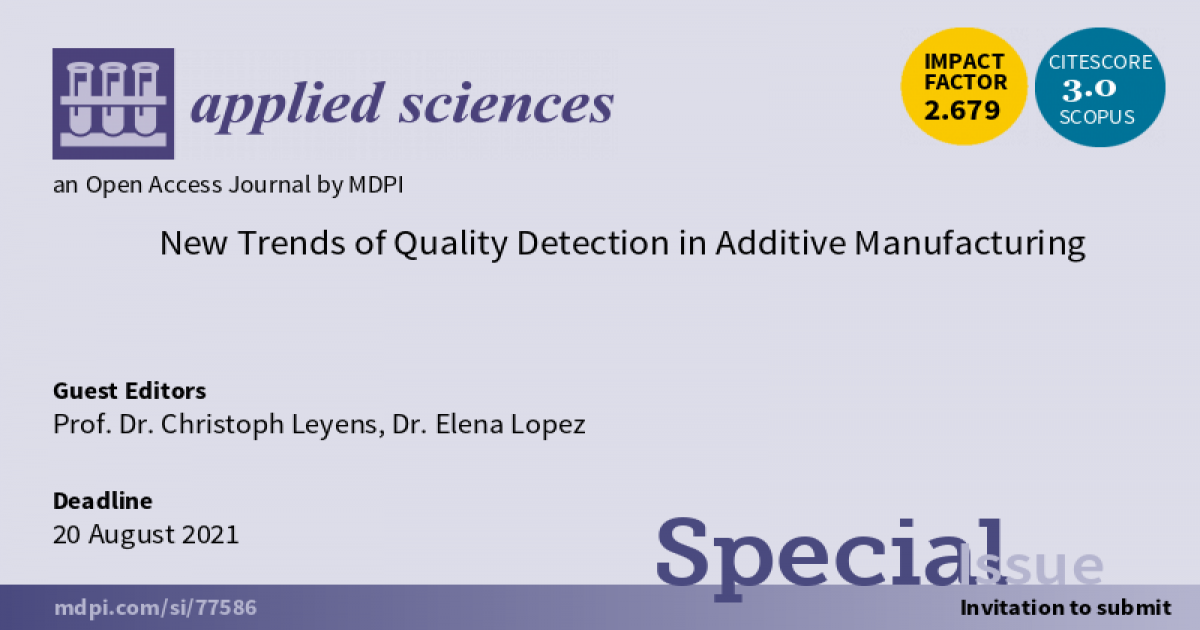- 2.5Impact Factor
- 5.5CiteScore
- 20 daysTime to First Decision
New Trends of Quality Detection in Additive Manufacturing
This special issue belongs to the section “Mechanical Engineering“.
Special Issue Information
Dear Colleagues,
Modern industry demands new technologies in order to use resources more efficiently and to contribute to a resilient society. Apart from a better performance of parts due to the use of advanced materials and new technologies, process optimization and a substantial increase in overall quality are crucial for achieving that goal. Additive manufacturing (AM) is a fast-growing industry that could lead to a revolution in the design of high-performance and lightweight parts. Regarding the AM process, a variety of different defects, such as a lack of fusion or delamination, can occur. If these are not detected properly and the related mechanisms remain incompletely understood, detrimental mechanical behaviour can lead to the critical failure of the part. Optimized part design, process optimization and post-processing quality testing can be applied as tools to avoid part failure. Due to advanced knowledge about the mechanisms of defect formation, parts can be designed so that defects in critical positions can be avoided. Furthermore, the number of defects can be reduced by optimizing the whole AM process. Concerning new trends in quality detection in AM, the nondestructive testing (NDT) of AM parts and in situ monitoring are gaining relevance, accelerating the industrialization of AM and paving the way to resource-friendly AM manufacturing. NDT, especially computer tomography (CT), is often used during process development to determine the optimal process parameters. In production, NDT can be used to control the quality of the generated parts; thereby, optimal mechanical behaviour and good life expectancy can be realized. It is often more economical to use faster NDT methods such as X-ray radiography, but the lack of accuracy and detail of the information must be taken into account. In addition, the application of artificial intelligence to quality management and the correlation of nondestructive part testing with in situ process monitoring data open up new possibilities for quality control in additive manufacturing.
Prof. Dr. Christoph Leyens
Dr. Elena Lopez
Guest Editors
Manuscript Submission Information
Manuscripts should be submitted online at www.mdpi.com by registering and logging in to this website. Once you are registered, click here to go to the submission form. Manuscripts can be submitted until the deadline. All submissions that pass pre-check are peer-reviewed. Accepted papers will be published continuously in the journal (as soon as accepted) and will be listed together on the special issue website. Research articles, review articles as well as short communications are invited. For planned papers, a title and short abstract (about 250 words) can be sent to the Editorial Office for assessment.
Submitted manuscripts should not have been published previously, nor be under consideration for publication elsewhere (except conference proceedings papers). All manuscripts are thoroughly refereed through a single-blind peer-review process. A guide for authors and other relevant information for submission of manuscripts is available on the Instructions for Authors page. Applied Sciences is an international peer-reviewed open access semimonthly journal published by MDPI.
Please visit the Instructions for Authors page before submitting a manuscript. The Article Processing Charge (APC) for publication in this open access journal is 2400 CHF (Swiss Francs). Submitted papers should be well formatted and use good English. Authors may use MDPI's English editing service prior to publication or during author revisions.
Keywords
- in situ monitoring
- NDT
- artificial intelligence in quality management
- additive manufacturing
- quality management

Benefits of Publishing in a Special Issue
- Ease of navigation: Grouping papers by topic helps scholars navigate broad scope journals more efficiently.
- Greater discoverability: Special Issues support the reach and impact of scientific research. Articles in Special Issues are more discoverable and cited more frequently.
- Expansion of research network: Special Issues facilitate connections among authors, fostering scientific collaborations.
- External promotion: Articles in Special Issues are often promoted through the journal's social media, increasing their visibility.
- e-Book format: Special Issues with more than 10 articles can be published as dedicated e-books, ensuring wide and rapid dissemination.

